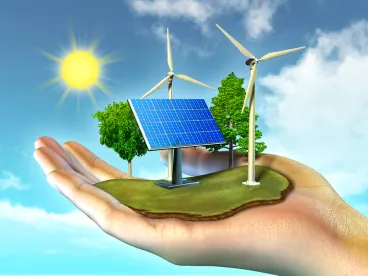Over the last several years, Clean Line Energy Partners LLC has been pursuing development of long-haul high-voltage direct current (HVDC) transmission lines, primarily to deliver energy created by wind and other renewables in lower populated areas to high-demand areas of the country. In 2016, the U.S. Department of Energy selected Clean Line’s Plains & Eastern Clean Line Project for its first public-private partnership for development of transmission facilities pursuant to a never-before-used section of the Energy Policy Act of 2005.
The Department of Energy’s authority to engage in transmission line siting and development has now survived its first legal challenge, but the future of the Plains & Eastern Project remains uncertain.
Previously Unused EPAct 2005 Section 1222: Department of Energy Partners with Clean Line
In 2016, we described in an article in Renewable Energy World the Department of Energy’s (Department or DOE) transmission siting activities pursuant to a previously unused section of the Energy Policy Act of 2005 (EPAct 2005), Section 1222 – “Third-Party Finance.” We predicted then that the Department’s authority to engage in activities that have traditionally been left almost exclusively to the states would be challenged in court. That prediction proved accurate, and last month a federal district court affirmed the Department’s interpretation of Section 1222 as authorizing it to “build transmission lines with private money,” even where a state utility commission has not authorized the transmission siting.
Historically, the siting of electric transmission facilities was the exclusive province of states. In Section 1222 of EPAct 2005, Congress gave the Department, acting through two of its federal power administrations (Western Area Power Administration (WAPA) and Southwestern Power Administration (SWPA)) the authority to upgrade existing transmission facilities owned by WAPA or SWPA to develop new transmission facilities within any state in which either operates. The statute permits the Department to “accept and use funds contributed by another entity for the purpose of carrying out” a transmission project.
Section 1222 thus broadly expanded federal involvement in transmission siting and development, either independently or in partnership with a third party.
As we previously reported, the Department first approved a Section 1222 project in March of 2016. That project was Clean Line’s Plains & Eastern Clean Line Project. Plains & Eastern is a planned 705-mile, 600 kV HVDC transmission line capable of delivering up to 4,000 MW of energy from the panhandle of Oklahoma to the Arkansas-Tennessee border. While Clean Line obtained public utility status from the Oklahoma Corporation Commission, the Arkansas Public Service Commission denied regulatory approval. In the absence of that state authorization, Clean Line sought DOE’s assistance in gaining authority for the Project. Six years after Clean Line requested the Department’s participation, the Department found that the Project met Section 1222’s requirements.
Challenge to DOE Transmission Siting Authority
Two groups of landowners in Arkansas (“Landowners”) challenged the Department’s authority to approve the Project (Downwind LLC v. United States Department of Energy, No. 3:16-cv-207-DPM (E.D. Ark. Dec. 21, 2017)). Landowners claimed that (1) the Project must be approved by the Arkansas Public Service Commission and (2) Section 1222 did not authorize the Department to take property for the Project by condemnation.
In a December 21, 2017 order (Order), the District Court for the Eastern District of Arkansas dismissed Landowners’ claims.
Holding: States Cannot Veto DOE Transmission Line Approval
In Downwind LLC, Landowners claimed that the Plains & Eastern Project required approval by the Arkansas Public Service Commission; since it had no such approval, Landowners argued, the Project could not proceed.
The court held that the Department did not act beyond its statutory authority in approving the Plains & Eastern Project pursuant to Section 1222 because, consistent with the statute, the “Department identified a grid shortcoming and, through a deliberative process, designed a new power line to address it.” Though Clean Line’s private investment “dollars will pay for the line,” the Project “is the United States’ sovereign action.” If Congress had intended for a state such as Arkansas to have veto power over whether a transmission line approved by the Department pursuant to its Section 1222 authority could be built, the statute would have to “make unambiguously clear that the federal government, which is usually exempt from state control, is subject to that control when building electrical lines paid for by third parties.” Section 1222 contains no waiver of sovereign immunity, so Arkansas Public Service Commission authorization was not required for the Project to go forward.
Furthermore, the court held that Section 1222, does not authorize the Department to “preempt . . . the many existing state regulations about transmission lines and facilities.” Rather, the statute “makes clear, by authorizing the Department to build interstate transmission lines with the help of non-federal funding, that the federal government can take on a larger role in electrical transmission.”
Holding: Objections to DOE’s Condemnation Authority Are Not Ripe
Landowners also objected to the Department’s authority to acquire easements by condemnation for transmission line siting.
The court held that, because no condemnation claims had actually been initiated, Landowners could not show a “concrete injury, actual or imminent.” A landowner who in the future does not “convey an easement will have the opportunity to contest any resulting condemnation.” That future opportunity, then, “makes any decision about condemnation now advisory.” Landowners’ condemnation claims were therefore dismissed without prejudice.
Holding: DOE Acted Reasonably and Carefully
In approving the Plains & Eastern Project, the Department of Energy “acted reasonably and carefully, not arbitrarily and capriciously,” as evidenced in the 95,060-page administrative record. The court held that the Department appropriately addressed the five required statutory factors: necessity of the project to meet actual or projected demand; consistency with transmission needs identified by an appropriate entity; the project’s conformity with prudent utility practices; the operation of the project by the appropriate transmission entity; and the project cannot duplicate existing or proposed transmission facilities.
The court also held that Landowners had not been deprived of due process with regard to the acquisition of easements for the Project, even though, as the court noted, there is “no question that this project casts a shadow” on the landowners’ property. The Department satisfied due process requirements through the issued notice of proceedings; fifteen public hearings in Oklahoma, Texas, Arkansas, and Tennessee; and consideration of the more than seven hundred comments it received.
CHANGES IN CLEAN LINE PROSPECTS
Two developments after the court’s Downwind LLC decision signal possible shifts in prospects for successful completion of the Plains & Eastern Project.
First, as announced on December 22, NextEra Energy Resources acquired Plains and Eastern Clean Line Oklahoma LLC and all of the assets for the Plains & Eastern Project in Oklahoma. Clean Line Energy retained Project assets east of Oklahoma—in other words, the portion of the Project at issue in the Downwind LLC legal challenge. No details about the transition from Clean Line to NextEra Energy Resources have yet been made available.
Second, the Tennessee Valley Authority (TVA) signed a memorandum of understanding with Clean Line in 2011 to consider a long-term agreement to purchase at least some of the energy delivered by the Plains & Eastern Project to TVA in Memphis, Tennessee. As of the end of 2017, though, TVA determined not to commit to such a long-term purchase, citing “flat” or “declining” future power demand. At this time, Clean Line is not pursuing an interconnection agreement with TVA for the Plains & Eastern Project, and has said that it will shift its focus to its other transmission projects.
TAKEAWAYS
Regardless of the fate of the Plains & Eastern Project, the viability of Section 1222 as a tool to facilitate the construction of transmission for renewables has been validated. It remains to be seen whether the DOE and developers will attempt to make use of it going forward.




 />i
/>i
